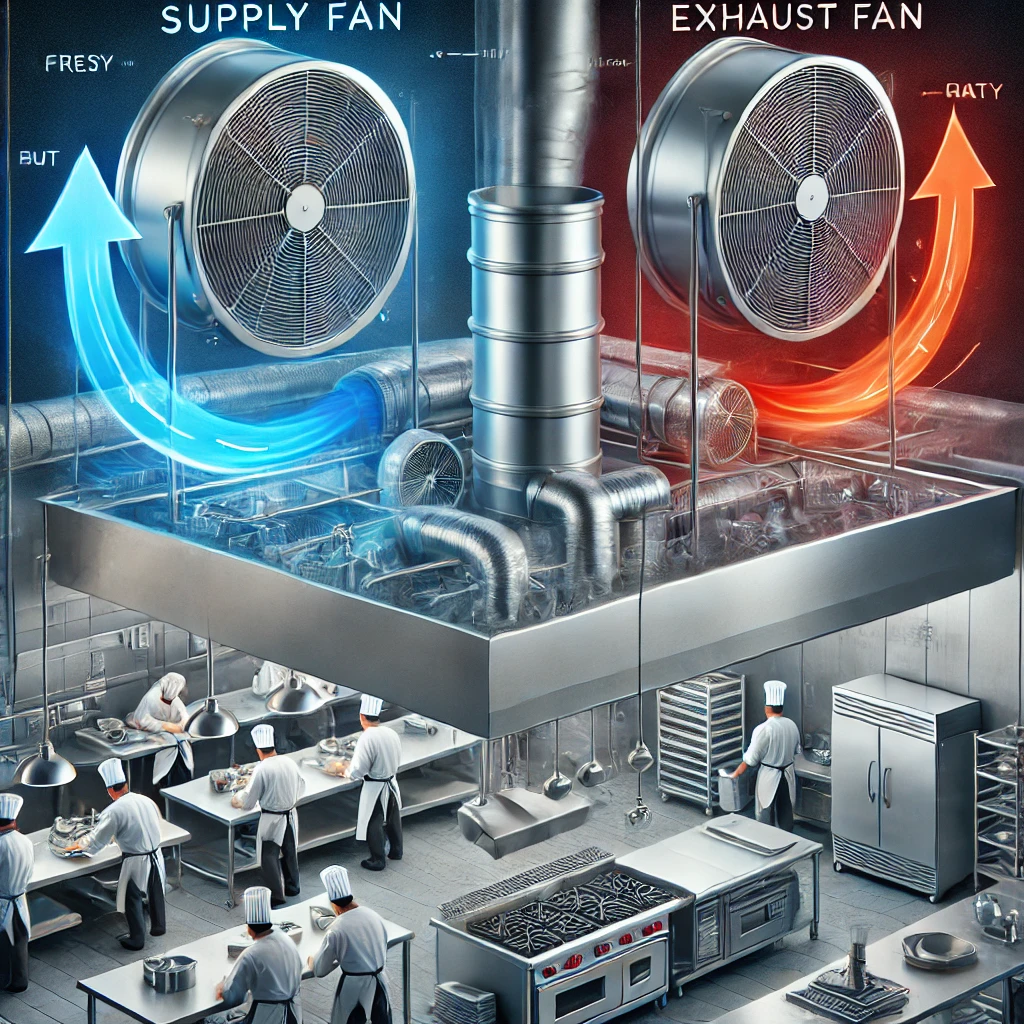When it comes to commercial kitchen ventilation, proper air circulation is crucial for maintaining a safe, efficient, and comfortable working environment. Two essential components of a well-functioning ventilation system are supply fans and exhaust fans. While they serve different purposes, they work together to ensure optimal air quality and regulatory compliance. Understanding the differences between these two types of fans will help restaurant owners and kitchen managers maintain effective ventilation.
What Is a Supply Fan?
A supply fan is responsible for bringing fresh air into the kitchen. In a commercial kitchen setting, air is continuously being removed by exhaust fans, which creates negative pressure. Supply fans help balance this by introducing outside air, ensuring proper airflow and preventing an excessive vacuum effect that can cause issues such as:
-
Difficulty in opening doors due to negative pressure
-
Poor air quality and oxygen depletion
-
Inefficient exhaust function due to insufficient replacement air
Types of Supply Fans:
-
Make-Up Air Units (MUA): Designed to replace the air removed by exhaust fans, MUA units heat or cool the incoming air to maintain indoor comfort.
-
Dedicated Outdoor Air Systems (DOAS): These systems bring in fresh, conditioned air independent of the HVAC system to maintain indoor air quality.
-
Rooftop Supply Fans: Mounted on the roof, these units deliver outside air directly into the kitchen space.
What Is an Exhaust Fan?
An exhaust fan is designed to remove unwanted air, including smoke, grease-laden vapors, heat, and odors from the kitchen. These fans are critical for maintaining a safe and compliant kitchen environment, as they help:
-
Prevent the buildup of heat and humidity
-
Remove airborne grease and contaminants
-
Improve indoor air quality for kitchen staff
-
Reduce the risk of fire hazards associated with grease accumulation
Types of Exhaust Fans:
-
Hood Exhaust Fans: Installed above cooking appliances, these fans capture and remove heat, smoke, and grease.
-
Upblast Exhaust Fans: Commonly used in restaurants, these roof-mounted fans expel air upwards to prevent grease buildup on the roof.
-
Inline Exhaust Fans: Installed within the ductwork, these fans provide additional ventilation for large kitchens.
Key Differences Between Supply and Exhaust Fans
| Feature | Supply Fan | Exhaust Fan |
|---|---|---|
| Function | Brings in fresh air | Removes contaminated air |
| Purpose | Balances air pressure | Prevents smoke, grease, and heat buildup |
| Location | Typically rooftop or wall-mounted | Mounted on hoods, roofs, or ducts |
| Effect on Airflow | Increases positive pressure | Creates negative pressure |
Why Proper Ventilation Balance Matters
A well-balanced ventilation system ensures that the kitchen operates efficiently without excessive heat, smoke, or air quality issues. Without adequate supply air, an overworked exhaust system may struggle to remove contaminants, leading to poor indoor air conditions and potential violations of health and safety codes. On the other hand, too much supply air without effective exhaust can cause discomfort by forcing contaminated air back into the kitchen.
Best Practices for Commercial Kitchen Ventilation:
-
Regularly maintain and clean both supply and exhaust fans to ensure peak performance.
-
Work with HVAC professionals to ensure the right balance of supply and exhaust airflow.
-
Invest in high-quality filtration systems to minimize grease buildup in ducts.
-
Ensure compliance with local building codes and health regulations for proper air exchange rates.
Conclusion
Understanding the difference between supply fans and exhaust fans is key to optimizing a commercial kitchen’s ventilation system. While supply fans introduce fresh air to balance negative pressure, exhaust fans work to remove heat, grease, and odors. Both are essential for maintaining a safe, comfortable, and compliant kitchen environment. Regular maintenance and proper ventilation design will keep your kitchen running smoothly and efficiently.
By investing in a well-balanced ventilation system, commercial kitchens can enhance air quality, improve worker comfort, and reduce the risk of fire hazards. Whether you're setting up a new kitchen or upgrading an existing one, working with ventilation experts will ensure you meet operational and safety standards effectively.

